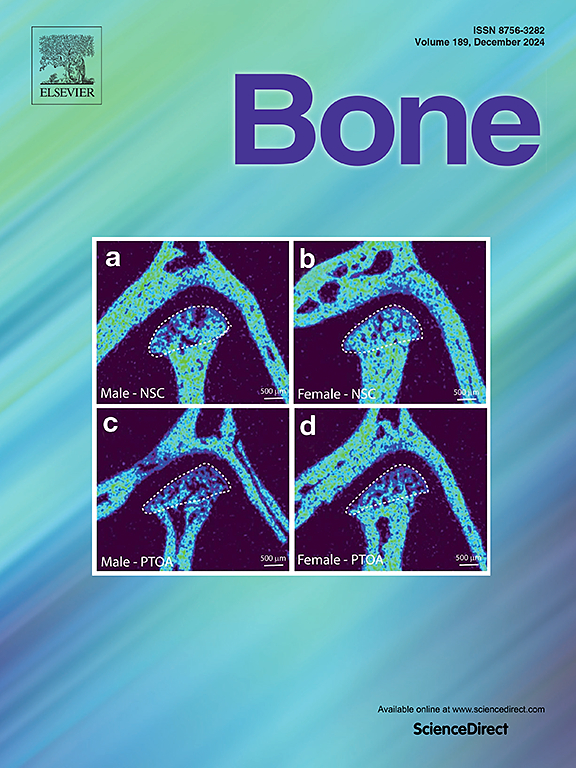统计形状和密度模型可以准确预测儿童骨形态和区域股骨骨密度变化。
IF 3.5
2区 医学
Q2 ENDOCRINOLOGY & METABOLISM
引用次数: 0
摘要
有限元分析(FEA)是一种广泛应用于骨科预防、治疗和植入物设计的骨生物力学预测工具。由于骨骼几何形状和骨矿物质密度的显著差异,特定主题的有限元模型比一般的成人比例模型更准确,特别是对于儿科人群。然而,创建这些模型既耗时又昂贵,还需要医学成像。为了解决这些局限性,基于人群的模型已经成功地表征了成人的骨形状和密度变化。然而,儿童不是矮小的成年人,需要他们自己的基于人口的模型来生成准确和可访问的儿童人群肌肉骨骼几何形状和骨矿物质密度。因此,本研究旨在创建一种生物力学研究工具,使用4至18岁 儿童人口的统计形状和密度模型来预测个性化的儿科股骨形状和密度。从330例儿童CT扫描中提取股骨形态和骨密度。使用主成分分析(PCA)捕获形状和密度的变化。主成分与人口统计学和线性骨测量相关联,以创建预测统计形状-密度模型,用于预测股骨形状和密度。留一分析表明,形状-密度模型预测股骨几何形状的均方根误差(RMSE)为1.78 ± 0.46 mm,股骨各区域骨矿物质密度的归一化RMSE为8.9 %至13.5 %。这些结果强调了该模型反映儿科股骨真实生理变化的潜力。这种统计形状和密度模型在使用部分或无医学成像数据快速生成个性化计算模型方面具有临床应用潜力。本文章由计算机程序翻译,如有差异,请以英文原文为准。
A statistical shape and density model can accurately predict bone morphology and regional femoral bone mineral density variation in children
Finite element analysis (FEA) is a widely used tool to predict bone biomechanics in orthopaedics for prevention, treatment, and implant design. Subject-specific FEA models are more accurate than generic adult-scaled models, especially for a paediatric population, due to significant differences in bone geometry and bone mineral density. However, creating these models can be time-consuming, costly and requires medical imaging. To address these limitations, population-based models have been successful in characterizing bone shape and density variation in adults. However, children are not small adults and need their own population-based model to generate accurate and accessible musculoskeletal geometry and bone mineral density in a paediatric population. Therefore, this study aimed to create a biomechanical research tool to predict the personalized shape and density of the paediatric femur using a statistical shape and density model for a population of children aged from 4 to 18 years old. Femur morphology and bone mineral density were extracted from 330 CT scans of children. Variations in shape and density were captured using Principal Component Analysis (PCA). Principal components were correlated to demographic and linear bone measurements to create a predictive statistical shape-density model, which was used to predict femoral shape and density. A leave-one-out analysis showed that the shape-density model can predict the femur geometry with a root mean square error (RMSE) of 1.78 ± 0.46 mm and the bone mineral density with a normalized RMSE ranging from 8.9 % to 13.5 % across various femoral regions. These results underscore the model's potential to reflect real-world physiological variations in the paediatric femur. This statistical shape and density model has the potential for clinical application in rapidly generating personalized computational models using partial or no medical imaging data.
求助全文
通过发布文献求助,成功后即可免费获取论文全文。
去求助
来源期刊

Bone
医学-内分泌学与代谢
CiteScore
8.90
自引率
4.90%
发文量
264
审稿时长
30 days
期刊介绍:
BONE is an interdisciplinary forum for the rapid publication of original articles and reviews on basic, translational, and clinical aspects of bone and mineral metabolism. The Journal also encourages submissions related to interactions of bone with other organ systems, including cartilage, endocrine, muscle, fat, neural, vascular, gastrointestinal, hematopoietic, and immune systems. Particular attention is placed on the application of experimental studies to clinical practice.
 求助内容:
求助内容: 应助结果提醒方式:
应助结果提醒方式:


